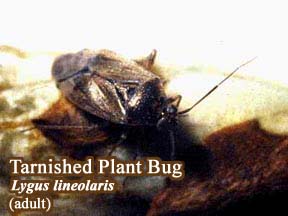Forsythia (Forsythia)
Plant Health Problems
Stem galls, cause unknown.
Galls form on stems and portions of the stem distal to the gall
eventually die. The cause of this malady is unknown, but it is
suspected to be a gall-forming fungus.
No control recommendation, other than pruning out galled stems,
can be made at this time.
Insect Problems:
 Plant bugs.
Plant bugs.
The fourlined plant bug, Poecilocapsus lineatus,
and tarnished plant bug, Lygus lineolaris, lay eggs in
soft stems. These hatch about the middle of May and the young
bugs suck the sap from the tender leaves of forsythia and many
other plants. They molt five times and when mature, about the
middle of June, they have wings and are nearly 1/3" long.
The fourlined plant bug is yellow-green, marked lengthwise on the
wings with four black stripes alternating with three green
stripes. The injury to the leaves consists of sunken areas around
the punctures. These areas later appear as circular transparent
spots and finally as circular holes. The tarnished plant bug is
mottled brownish, 1/5" long, with a yellow "Y"
shape pattern on its back. There is one generation each year of
the fourlined plant bug and two to five generations yearly of the
tarnished plant bug. The nymphs can be managed by spraying with
azadirachtin, ultrafine horticultural oil, insecticidal soap or
malathion, which are among the compounds registered for control
of this pest in Connecticut. Consult the labels for dosage rates
and safety precautions.
Twobanded Japanese weevil, Callirhopalus
bifasciatus.
The weevils, which consist of only females, feed on the margins
of the leaves of azalea, barberry, rhododendron and other shrubs,
leaving characteristic crescent-shaped notches. The weevil is
about 1/5" long, robust, and varied brown in color. The wing
covers have faint whitish lines and whitish spots on the apex.
Spray acephate which is registered for control of this pest in
Connecticut, in early August if many adults are noticed and
damage is intolerable. Consult the label for dosage rates and
safety precautions.

